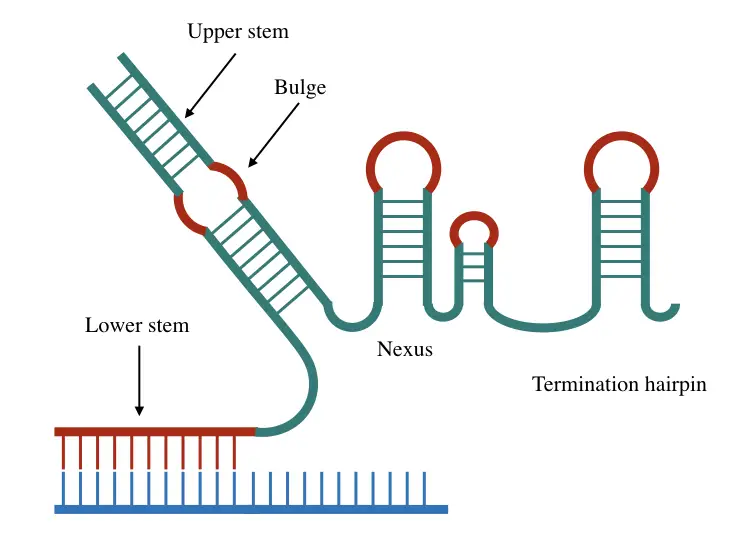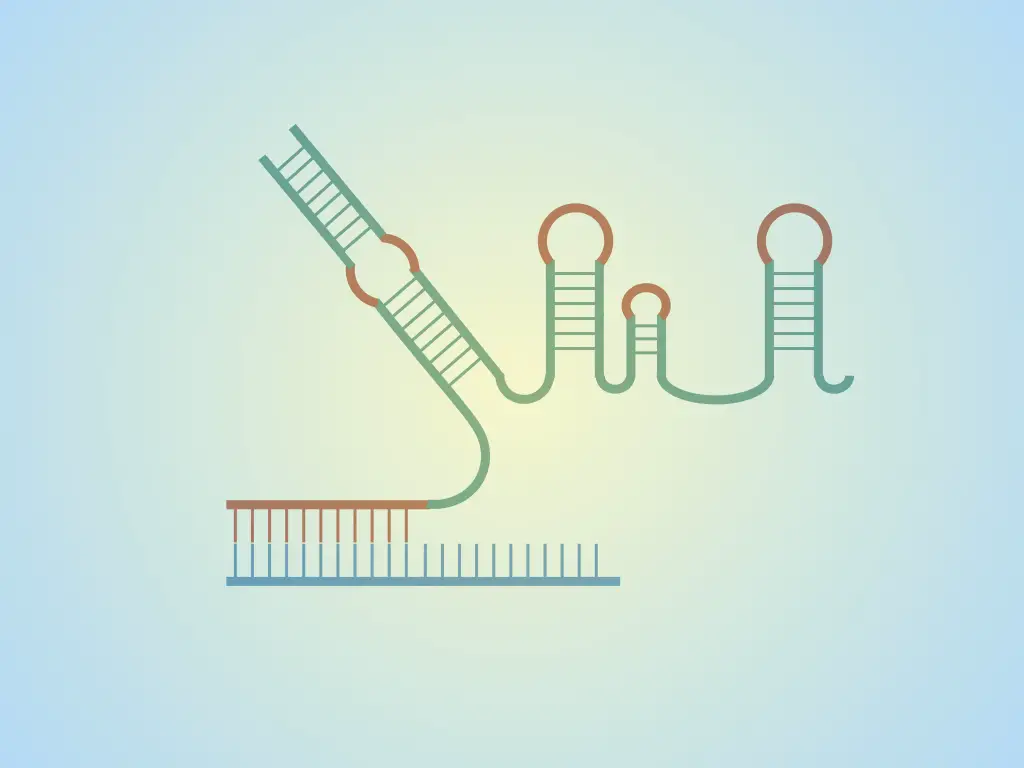tracrRNA short for Trans-active crRNA binds with the crRNA and guides the CAS protein for effective DNA cleaving.
“CRISPR-CAS9 system is an integral part of the bacterial immune system and an effective gene-editing tool”, a fact known and popular among science and biology students.
Naturally, the setup CRISPR system is a formal composition of CRISPR sequence, CAS protein and sgRNA. The trio collectively destroys the invader DNA of Phage, interestingly the same mechanism has been well studied for in vitro gene therapy.
Perhaps, the system looks simple but it’s a complex- system and process which includes many miniature biomolecules and composite processing.
For instance, the sgRNA (single-stranded guided RNA)– known to use, we know, it guides the CAS nuclease towards the target, but do you know the sgRNA is made up of two separate single-stranded RNA types and each has an individual function?
Similarly, there are tons of various minute details students don’t even know about. If you wish to strengthen your CRISPR knowledge everything should be known to you. And that’s why I am writing to explain every minute detail in my blogs in layman, simple and effective language.
“tracrRNA is required in a separate and specific bacterial CRISPR system having a significant role in the maturation of pre-crRNA”, said Charpentier E, Chylinski K & Rhun, scientists from the Hannover Medical school, Hannover, Germany; Helmholtz Centre for infection research, Braunschweig, Germany; Max F. Perutz laboratories and the laboratory of molecular infection medicine Sweden, Umea, Sweden.
In their research article entitled, “ The tracrRNA and Cas9 families of type II CRISPR Cas immunity systems”, published in 2013 explained that another kind of non-coding trans-activating crRNA has been characterized to have a decent function in crRNA maturation and Cas recognition.
Their groundbreaking finding helped Charpentier E to achieve Nobel Prize 2020 that exclusively suggests that tracrRNA has an integral function in CRISPR. And that is what we are discussing here, the importance of tracrRNA.
Quick look:
| tracrRNA | trans-activating crRNA |
| Structure | Single-stranded, non-coding RNA |
| length | 68 to 108nt |
| Function | crRNA maturation and allocated Cas9 to target |
| Present in | Bacterial CRISPR system II |
Key Topics:
What is TracrRNA?
tracrRNA stands for trans-activating crRNA which is a short, single-stranded, complementary to crRNA, RNA strand which helps the crRNA for proper navigation of Cas protein to the target location.
The trans-encoded RNA has complementation with the repeat region of the crRNA and was first reported by Emmanuelle Charpentier from human streptococcus pyogenes. Charpentier E was awarded the Nobel Prize in 2020 for their findings.
Bacterial defense system CRISPR type II requires the tracrRNA for integration and interference. Bacterial CRISPR type I and II lack tracrRNA as each Cas protein during integration and interference performs their function directly using the crRNA.
If you would like to learn more about various CRISPR systems, integration and interference processes in bacterial CRISPR, read our previous article (link is given above).
Important information
Cas1 is the most prevalent nuclease found in all types of CRISPR systems whose function is to integrate spacer.
Cas1 is the most common in all CRISPR systems while Cas2 is the most conserved nuclease in all CRISPR systems.
Structure of tracrRNA:
The structure of the tracrRNA has vital importance in CRISPR processing and therefore designing the tracrRNA artificially becomes even more crucial for in vitro experiments.
Structurally, it consists of the upper stem, bulge, nexus and hairpin part among which the upper stem takes part in base pairing with the crRNA. Notedly, it’s 68 to 108nt long (Crawley AB et al., 2018).

Mechanism of action:
A short tracrRNA binds to its complementary location to the pre-crRNA which is a precursor to the CRISPR locus. It eventually forms the RNA: RNA duplex.
RNase III or RNA-specific ribonuclease cleaves and trims this hybrid to make it ready- recognizable for the Cas. A correctly processed tracrRNA: crRNA hybrid is identified by a specific Cas nuclease.
The RNA-specific ribonuclease activity (trimming and processing) manufactures the mature crRNA whose composition is a spacer and repeats only. The spacer and repeat sequence of the mature crRNA make base pairing with the protospacer (target) and tracrRNA, respectively.
The complex navigates Cas to the target location on the protospacer sequence at where it first finds the correct PAM (proto adjacent motif) and then performs a catalytic reaction. Note that the mechanism is only reported in bacterial CRISPR system II.
Carpentier E et al., also explained that the tracrRNA sequence is located near the Cas encoding gene cluster.
Importance of TracrRNA:
In bacterial CRISPR system II, the tracrRNA performs two important functions:
- Maturation of crRNA
- Navigation for the Cas nuclease
As we talked, the RNA III mediated trimming process helps mature the crRNA while the dsRNA hybridize, recognizable to the Cas helps the nuclease to find the target location.
Note
The length and the structure of tracrRNA and crRNA vary among species and genera of species.
The reason why the tracrRNA is present only in the Type II CRISPR system (specifically in Type II A) has been clearly unknown. However, perhaps it’s because of the signature Cas protein- Cas9 of Type II A CRISPR system, explained Crawley AB et al., (2018) in their article, “Characterizing the activity of abundant, diverse and active CRISPR-Cas system in Lactobacilli.
Cas9, related systems and associated assays need the tracrRNA to work efficiently for bacteria as well as for in vitro processing.
tracrRNA in gene therapy:
CRISPR is a complex system comprising numerous pathways and molecules. One of the integral structural elements is tracrRNA though known to us but significantly less known in terms of function.
“The tracrRNA also autoregulates CRISPR-Cas expression by reprogramming the Cas9 function,” described Workman R and Pammi T el a., (2021) in their article entitled, “A natural single-guided RNA repurposes Cas9 to autoregulate CRISPR-Cas9 expression.
Two types of tracrRNA are reported in various bacteria- short tracrRNA (tracrRNA-S) and long-form tracrRNA (tracrRNA-L) among which the tracrRNA-L has been known for its role in decreasing the autoimmune response.
The tracrRNA-S is structurally short and binds with the guide RNA for Cas9 to work while the tracrRNA-L behaves like the guide RNA itself and doesn’t need a specific gRNA for Cas9 to work, they explained further.
However, to avoid unnecessary complications scientists usually use the short-form tracrRNA for gene therapy experiments. In vitro model organism studies suggest that the artificially designed tracrRNA must have a repeat sequence complementary to the crRNA.
In addition, for Cas9 to recognize it, it should also have other tracrRNA structural elements as well, much like the natural tracrRNA. Scientists are performing various studies to optimize the sgRNA design by shortening or experimenting on it.
Longer tracrRNA in the experimental setup creates unnecessary complexity and reduces efficiency. As the base synthesis process is costlier, It also uplifts the overall cost too.
An effectively designed tracrRNA increases the efficiency of the guided RNA complex for target degradation and gene silencing. Nonetheless, the complete function of tracrRNA has still remained largely unclear.
Several studies currently reported demonstrating that modifying the tracrRNA improves gene therapy efficiency. Scott T & Urak R et al., (2019) explained in their research that modification in tracrRNA can improve Cas9 RNP activity, further improve Cas9 efficiency, improve Cas9 activity for other crRNAs and for CD4+ T cells.
Relevant articles:
Wrapping up:
As I always say, “CRISPR is amazing and futuristic”, a technique that would potentially change the fate of humanity and let us survive on earth. At the same time, it’s a complex process too.
It isn’t fully known to us and so are its various components as well. tracrRNA is one of them though significantly important but less known. Studies also suggest that the importance of various tracrRNA structural locus is unknown too. Noteworthy, it has a primitive role in bacterial autoimmunity.
More articles:
- Applications of CRISPR-CAS9 in Medical Science, Diagnostics, Research, Plant Biology and Agriculture.
- Explaining CRISPR-CAS9 System- Step by Step.
- What is Gene Editing and CRISPR-CAS9?
- dCAS9 (Dead CAS system): Concept, Functions and Applications
FAQs
Sources:
Chylinski K, Le Rhun A, Charpentier E. The tracrRNA and Cas9 families of type II CRISPR-Cas immunity systems. RNA Biol. 2013;10(5):726-737. doi:10.4161/rna.24321.
Karvelis T, Gasiunas G, Miksys A, Barrangou R, Horvath P, Siksnys V. crRNA and tracrRNA guide Cas9-mediated DNA interference in Streptococcus thermophilus. RNA Biol. 2013;10(5):841-851. doi:10.4161/rna.24203.
Te-yuan Chyou & Chris M Brown (2019) Prediction and diversity of tracrRNAs from type II CRISPR-Cas systems, RNA Biology, 16:4, 423-434, DOI: 10.1080/15476286.2018.1498281.
Guilhem Faure, Sergey A. Shmakov, Kira S. Makarova, Yuri I. Wolf, Alexandra B. Crawley, Rodolphe Barrangou & Eugene V. Koonin (2019) Comparative genomics and evolution of trans-activating RNAs in Class 2 CRISPR-Cas systems, RNA Biology, 16:4, 435-448, DOI: 10.1080/15476286.2018.1493331.
Scott, T., Urak, R., Soemardy, C. et al. Improved Cas9 activity by specific modifications of the tracrRNA. Sci Rep 9, 16104 (2019). https://doi.org/10.1038/s41598-019-52616-5.


